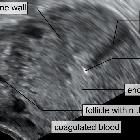Pregnancy with intrauterine contraceptive device







Pregnancy with intrauterine contraceptive device (IUCD) is uncommon and IUCD is a highly effective contraception method. Chances of pregnancy to occur is highest during the 1st year of IUCD usage and there are chances of adverse outcomes during pregnancy.
Epidemiology
Pregnancy with IUCD may occur in as high as 2 in 100 females, although recently published figures state 0.2% occurrence in levonorgestrel-releasing IUCD and 0.8% in copper-releasing IUCD .
Complications
Neonatal
- low birth weight
- low APGAR score
- higher neonatal admission rate
Gestational
- ectopic pregnancy
- preterm labor
- chorioamnionitis
- spontaneous miscarriage
Treatment and prognosis
The management of these patients is based on the gestational age and IUCD location. The difficulty and risk of removal of the IUCD increase with advancing gestational age, so early identification of an intrauterine pregnancy and IUD result in a better prognosis.
During the first trimester, removal of the IUD is recommended. However, this decision is to be made weighing the risks and the benefits. If the location makes removal difficult or will disrupt the pregnancy, the risks of IUCD removal outweigh the benefits.
Removal during the second trimester is riskier as it may potentially lead to the rupture of membranes, excessive bleeding, or even fetal loss. US localization is critical for the decision-making and removal is again based on location and lack of incorporation into the placenta or gestational sac.
Beyond the late second trimester, the risks of removal are more than the benefits.
Siehe auch:


 Assoziationen und Differentialdiagnosen zu
Assoziationen und Differentialdiagnosen zu 
